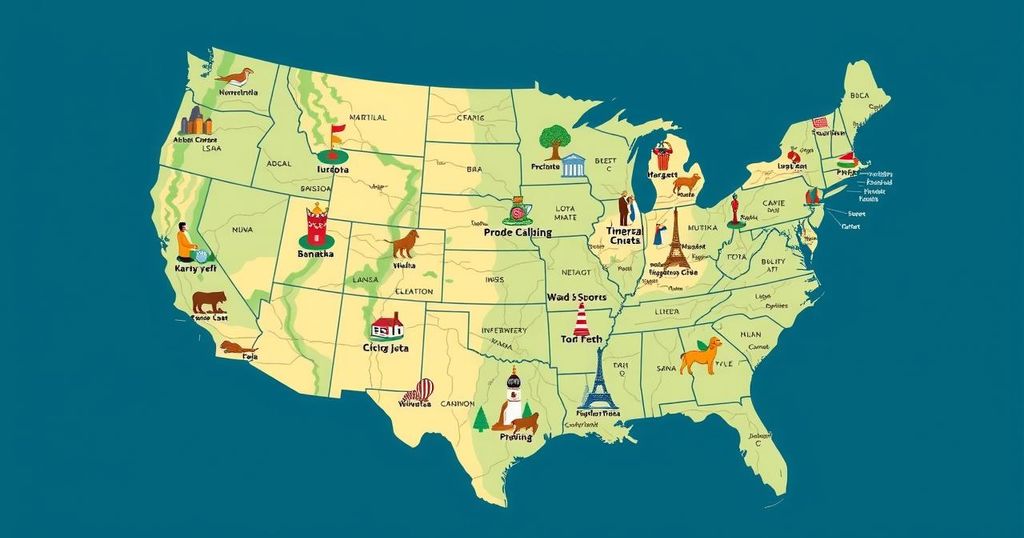The article examines the United States’ socio-economic landscape through 20 maps, addressing factors like GDP distribution, unemployment rates, minimum wage differences, racial demographics, and current social issues such as homelessness and crime. With the elections on November 5, 2024, this comprehensive overview provides crucial insights for voters to understand the context of their electoral choices.
Al Jazeera presents an analytical overview of the United States’ economic landscape, demographic distributions, geographical features, and historical context in light of the upcoming elections on November 5, 2024. Through a series of informative maps and data, this comprehensive article elucidates various critical indicators shaping the electoral environment. America’s economy stands as the most significant globally, boasting a Gross Domestic Product (GDP) of approximately $29 trillion. Within the nation, California, Texas, and New York emerge as economic powerhouses with respective GDPs of $4.8 trillion, $2.9 trillion, and $2.3 trillion, showcasing economic clout, comparable to leading global economies. The unemployment rate, as reported by the Bureau of Labor Statistics, currently stands at 4.1 percent, affecting about seven million Americans. Economically prosperous states such as the District of Columbia, Nevada, and California exhibit higher unemployment rates, while states such as South Dakota, Vermont, and North Dakota maintain much lower figures. Additionally, the minimum wage debate highlights disparities among states, with notable minimum wage levels in DC, Washington, and California, contrasted against lower rates in states like Georgia and Wyoming. Income tax rates reveal California’s financial policies, with the highest tax rate at 13.3 percent. Conversely, several states, including Texas and Florida, impose no income tax, opting for alternative revenue channels. The issue of homelessness remains critical, with national rates reported at approximately 20 individuals homeless per 10,000. The highest concentrations exist in urban centers like the District of Columbia and New York. Further shedding light on wealth distribution, the United States houses the majority of the world’s wealthiest individuals, with Elon Musk residing in Texas and Jeff Bezos in Florida, establishing a narrative of affluence. Geographically, the United States is the third largest country globally, exhibiting vast physical size variability amongst its states. California, Texas, and Alaska represent the largest states, with populations concentrated predominantly in urban areas. California leads in population, with nearly 39 million residents, while Wyoming is the least populated state. Diving into immigration trends, California reaffirms its role as a hub for foreign-born populations, accommodating 27 percent of its residents from outside the US. This demographic aspect is significant in political discussions, emphasizing divergent views on immigration policies. The 2020 census signals crucial shifts in the racial and ethnic composition of the United States, highlighting a decrease in White non-Hispanic populations from 63.7 percent in 2010 to 57.8 percent in 2020, with notable growth in Hispanic and Black populations across the nation. Additionally, the article outlines concerning statistics regarding youth voting and maternal mortality rates, alongside alarming trends in suicide and violent crime rates within specific states. Such statistics illustrate the pressing issues that voters may weigh in the upcoming elections. Examining gun violence, the United States has recorded the highest number of mass shootings in recent years, with Illinois leading in incidents. State responses to justice and the death penalty continue to shape public opinion as several states have either enforced or laid down capital punishment laws. As the United States moves forward, recent rulings affecting abortion rights and state joinings post the original colonies signal ongoing changes in the political landscape and societal norms. \n In summary, these maps and accompanying analyses depict a multifaceted portrait of the United States, intricately linked to economic stability, demographic shifts, and pressing social issues, all underlined by the imminence of a major electoral event.
This article explores the critical socio-economic indicators and demographic characteristics of the United States as they pertain to the upcoming elections in November 2024. The focus on maps serves as a visual aid to help readers comprehend the diverse landscape of American society, including economic strength, employment rates, racial and ethnic compositions, and prevalent social issues such as homelessness and crime. The data-driven insights provide voters with a clearer understanding of the context in which electoral decisions are made, enabling informed participation in the democratic process.
In conclusion, as the United States approaches the pivotal elections of 2024, understanding the multifaceted dynamics illustrated through these maps is essential for voters. The economic indicators, demographic changes, and social issues that have been highlighted reflect broader trends that could influence electoral outcomes. Voters are encouraged to consider these factors carefully, as they may significantly impact policy decisions and the future direction of the nation.
Original Source: www.aljazeera.com






